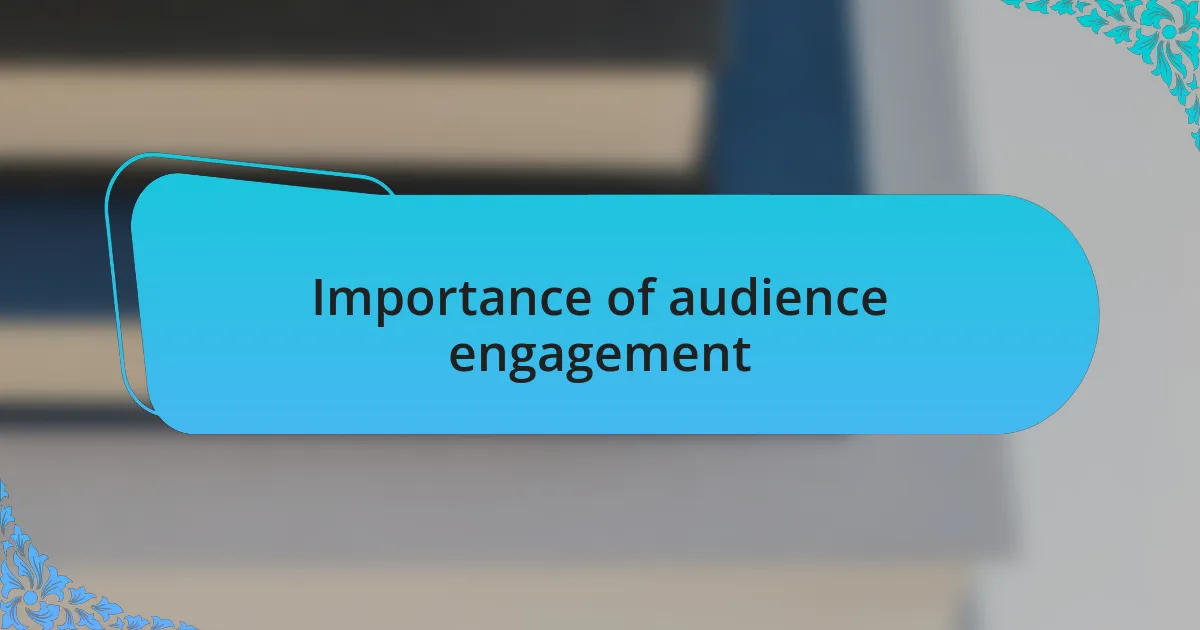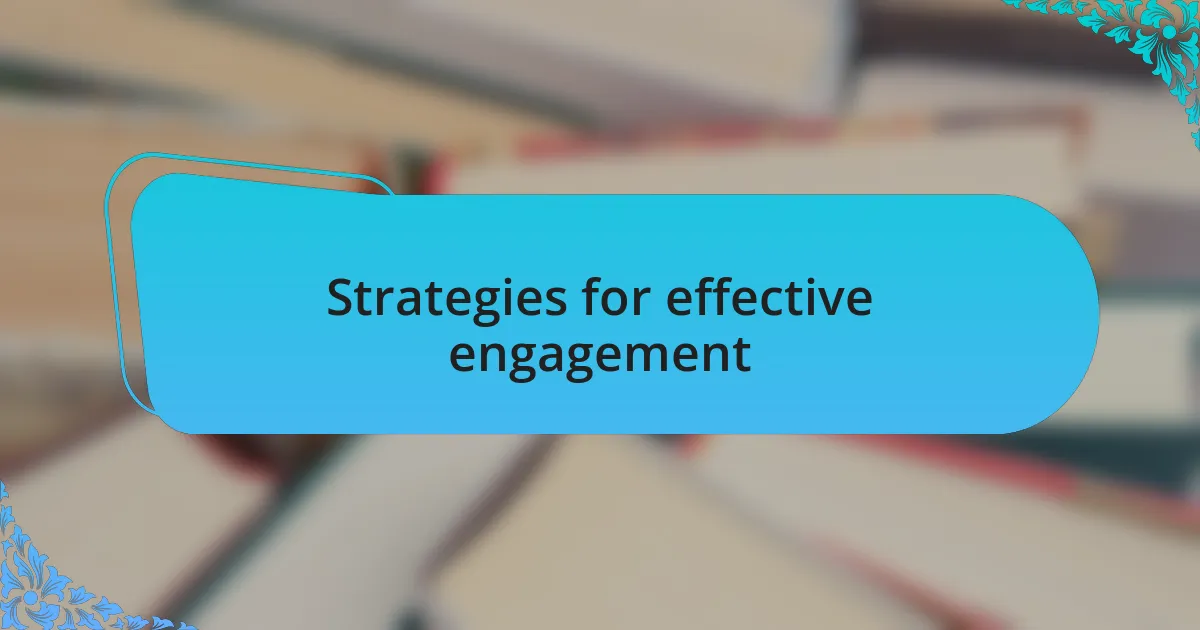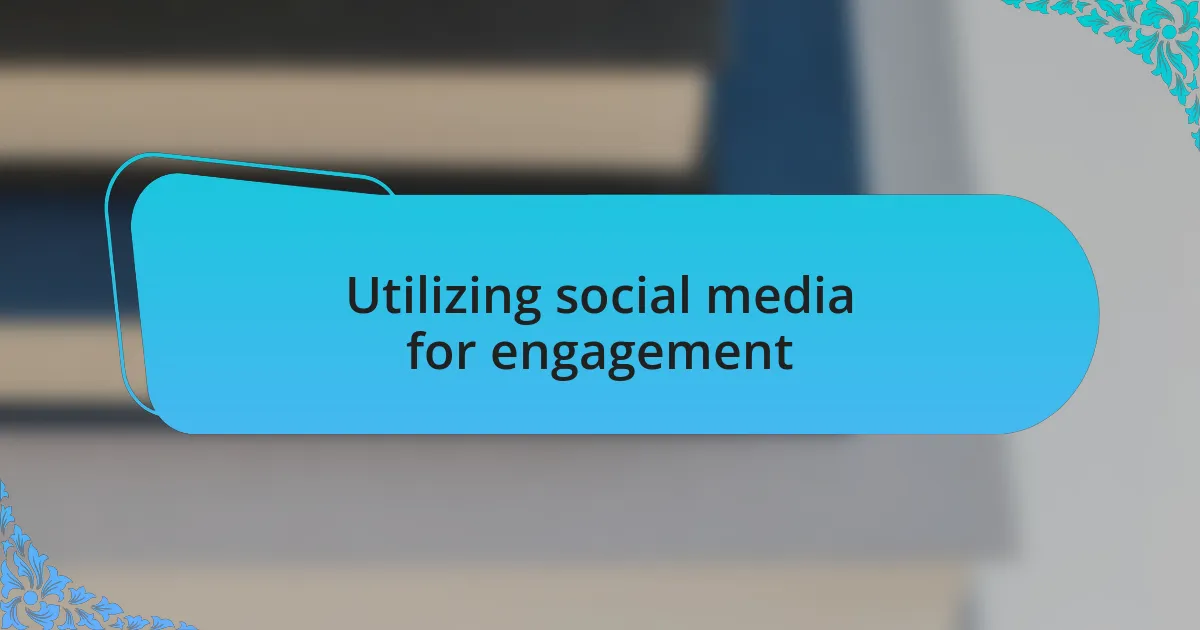Key takeaways:
- Audience engagement creates emotional connections that transform attendees into passionate advocates for events.
- Interactive formats, such as collaborative activities and real-time social media engagement, significantly enhance the festival experience.
- Personal stories shared during festivals foster deeper connections and a sense of community among participants.
- Measuring engagement success involves assessing emotional responses and lasting impacts, rather than just attendance numbers.

Understanding audience engagement
Understanding audience engagement is a nuanced process that goes beyond just attracting visitors. When I reflect on my experiences at various literary festivals, I recall the palpable energy in the room when authors interacted directly with their fans. Have you ever felt that rush of excitement while waiting for a book signing? It’s that personal connection that transforms a casual attendee into a passionate advocate for the event.
Delving deeper, audience engagement thrives on emotional resonance. I remember a moment at a festival when a poet shared a heartfelt piece about loss and recovery. The silence that followed was thick with empathy, a collective understanding among the audience. This moment sparked discussions that continued well beyond the event. How can we create similar experiences that linger in the minds of our guests?
Ultimately, it’s about creating spaces where individuals feel seen and heard. I’ve often found that engaging the audience is about asking questions that reflect their interests, rather than merely delivering information. When we facilitate conversations that matter to our audience, we foster loyalty and community, ensuring they return not just for the content, but for the connection.

Importance of audience engagement
Engaging an audience is not just beneficial; it’s essential for the vibrancy of any literary festival. I recall a festival where I volunteered, and the organizers emphasized interaction in unique ways, like Q&A sessions with authors. This simple strategy not only drew in larger crowds but transformed the atmosphere, sparking conversations that allowed attendees to feel like part of something bigger.
Another time, I witnessed a workshop where participants shared their own writing inspirations. The energy was electric, and you could see attendees connecting on deeper levels through their stories. It made me realize how crucial it is to provide platforms for these personal narratives, as they help attendees recognize their own voices within the broader tapestry of literature. Isn’t it fascinating how a shared story can make someone feel validated and uplifted?
Ultimately, the importance of audience engagement lies in its ability to build lasting connections and foster a sense of belonging. When I think back to festivals that left a mark on me, what stands out is not just the authors or books but the relationships formed among attendees. Are we prioritizing those connections enough? By actively engaging our audience, we open the door to a community that thrives long after the last book has been signed.

Strategies for effective engagement
When it comes to engaging an audience at a literary festival, one strategy I’ve found incredibly effective is collaborative events. I once participated in a brainstorming session with local poets, where attendees contributed lines to form a collective poem. This hands-on activity not only spotlighted various voices but also ignited a sense of ownership among participants, making them feel integral to the creative process. Can you imagine the pride someone must feel when their words are part of a shared creation?
Additionally, utilizing social media for real-time engagement can be a game-changer. At a recent festival, I noticed how dynamic and responsive interactions were when the organizers encouraged participants to tweet questions during panels. This immediate feedback not only enriched the conversation but allowed attendees to feel heard and valued. Did you ever think how invigorating it is to see your question acknowledged by a visiting author?
Another compelling approach is to create immersive experiences that weave storytelling into the fabric of the festival. I vividly recall a particular event where participants wandered through a themed literary trail, each stop revealing different genres and authors. This multi-sensory journey made the stories come alive in a way that traditional formats simply can’t match. What if we could transform every literary festival into an adventure that captivates the imagination and sparks curiosity about literature?

Creating immersive festival experiences
Creating immersive experiences at a literary festival can truly transform the atmosphere and the way guests interact with literature. I once attended a festival that featured a live-reading theater, where actors brought powerful scenes from classic novels to life. The energy in the room shifted palpably; you could feel the audience’s anticipation grow with every narration. Have you ever felt your heart race while immersed in a dramatic storytelling session?
Another fantastic method I’ve seen involves integrating local artists and crafts into the festival environment. At a festival I participated in, local artisans created installations inspired by famous works, allowing attendees to literally walk through the pages of their favorite stories. This connection between visual art and literature made the experience uniquely engaging and evocative. How thrilling is it to encounter a work of art that resonates with an emotional moment from a beloved book?
Lastly, including interactive workshops where attendees can craft their own stories can heavily enrich the festival experience. I vividly remember a session where participants collaborated on a story, with each person adding a unique twist. The laughter and surprise in the room made it clear: everyone left feeling invigorated and inspired. Wouldn’t it be magnificent if we could harness that creative energy and carry it beyond the festival?

Utilizing social media for engagement
Social media plays a crucial role in engaging audiences for a literary festival. I remember a festival where the organizers actively used Twitter to create a buzz before the event. By sharing sneak peeks of author interviews and behind-the-scenes moments, they generated excitement that translated into higher ticket sales. Have you ever felt the thrill building up as you anticipate a big event, just from a series of intriguing tweets?
Platforms like Instagram and Facebook also offer opportunities for real-time interaction. For instance, I once participated in a live Q&A session with an author via Instagram Stories. The chat was lively, and fans submitted questions that sparked heartfelt discussions. Seeing the enthusiasm from both sides made me realize just how powerful social media can be in fostering a community around literature. Isn’t it invigorating to connect with someone whose work you admire?
Finally, utilizing user-generated content can enhance engagement. At one festival, attendees were encouraged to share their festival experiences using a specific hashtag. I still cherish the colorful posts and the genuine reviews that filled my feed. Each photo and story created a tapestry of shared memories, making the festival feel like a collective journey. Wouldn’t it be fantastic if we all had the chance to contribute to such a meaningful narrative?

Personal anecdotes from past festivals
One of my favorite memories from a literary festival happened a few years ago when I attended a panel discussion featuring debut authors. I was seated in the front row, and when one of them shared her journey of facing rejection after rejection, I felt an emotional connection. It was a reminder that success often comes with struggles, and hearing her story encouraged me to keep pursuing my own literary dreams. How often do we miss the richness of a story if we only focus on the polished end result?
At another festival, I found myself engrossed in a spontaneous poetry slam that took place in a cozy corner of a café. The atmosphere was electric, with each performance drawing cheers and applause from the audience. I couldn’t help but feel a sense of unity among those present, as we all vibed off the raw emotions expressed through the verses. Have you ever been in a moment where you realize that art has a way of bridging gaps between strangers?
Lastly, I recall one festival where an author signed copies of their latest book. The queue was long, but the anticipation was palpable. When it was finally my turn, I nervously shared how their work had influenced my writing. Their warm smile and the way they took a moment to discuss my thoughts stuck with me—it’s these personal interactions that elevate a festival experience beyond mere attendance. Don’t you think that personal connections can truly transform how we perceive events like these?

Measuring engagement success
When it comes to measuring engagement success at literary festivals, I often reflect on the diversity of interactions that signify deeper connections. Take, for instance, the captivating energy in the audience during a book reading. As I looked around, I could see faces lighting up, nodding along with each word. This kind of visceral reaction is an indicator of engagement that goes beyond mere attendance numbers.
In another experience, I noticed a spike in social media interactions after a particularly inspiring workshop. Participants began sharing quotes, moments, and even their own writing inspired by what they had learned. It makes me wonder—how do we quantify these intangible moments? Tracking hashtags and comments can provide valuable insights into which events resonate most with attendees.
I also value the feedback collected through post-festival surveys. I remember reading a heartfelt testimonial from someone who attended a panel on mental health in literature. Their words about feeling seen and understood were profound. It really highlighted for me that the true measure of engagement is not just in numbers, but in the lasting impact we leave on individuals. How often do we forget that engagement is as much about fostering community as it is about metrics?